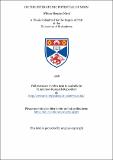Files in this item
On the interatomic potential of neon
Item metadata
| dc.contributor.advisor | ter Haar, D. | |
| dc.contributor.author | Nicol, William Menzies | |
| dc.coverage.spatial | 166 p. | en_US |
| dc.date.accessioned | 2018-06-25T11:27:53Z | |
| dc.date.available | 2018-06-25T11:27:53Z | |
| dc.date.issued | 1956 | |
| dc.identifier.uri | https://hdl.handle.net/10023/14532 | |
| dc.description.abstract | It is not an exaggeration to say that the knowledge of the interatomic potential energy is the stepping stone to the physical properties of matter. In the case of gases the most important commutation on the path of development is between the interatomic potential energy on the one hand and the equation of state and the transport properties – viz. conductivity, viscosity and diffusion – on the other hand. However, for the solid state, the role of interatomic forces in crystal structures should not be overlooked. It is clear that the development is reversible in that the potential energy could be determined from one or more of the physical properties mentioned above and vice versa. A great many of the existing interatomic potential energies in the literature are of this phenomenological kind obtained by fitting the experimental results to an analytic function. Theoretically it should be possible to determine this energy from first principles and thereby arrive at values for the physical properties for comparison with the experimental results. The latter is the objective of this investigation. | en_US |
| dc.language.iso | en | en_US |
| dc.publisher | University of St Andrews | |
| dc.subject.lcc | QC174.1N5 | |
| dc.subject.lcsh | Quantum theory | en |
| dc.title | On the interatomic potential of neon | en_US |
| dc.type | Thesis | en_US |
| dc.contributor.sponsor | Sir James Caird Trust | en_US |
| dc.type.qualificationlevel | Doctoral | en_US |
| dc.type.qualificationname | PhD Doctor of Philosophy | en_US |
| dc.publisher.institution | The University of St Andrews | en_US |
This item appears in the following Collection(s)
Items in the St Andrews Research Repository are protected by copyright, with all rights reserved, unless otherwise indicated.

